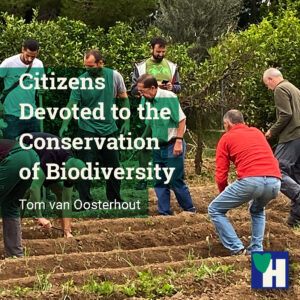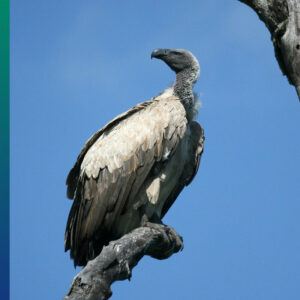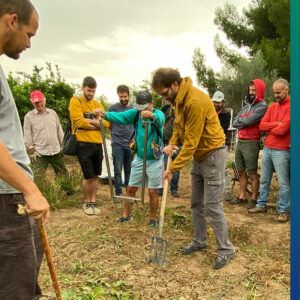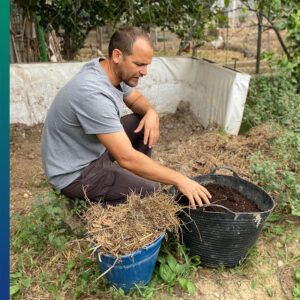
The conservation of biodiversity appeals to many citizens. In this article, I introduce 2 examples of citizens initiatives, committed to the conservation of biodiversity: GREFA, a wildlife biodiversity initiative, and RMDS, an agricultural biodiversity initiative.
Because we live in Spain, the examples are Spanish. We’re convinced, however, that these types of citizen initiatives can be found everywhere.
GREFA is a citizens’ wildlife conservation intitiative: Grupo de Rehabilitación de la Fauna Autóctona y su Hábitat (Group for the Rehabilitation of Autochthonous Fauna and its Habitat).
RMDS is committed to the conservation of the biodiversity of organic agricultural seeds. This initiative is called Red Murciana de Semillas (Murcian Seeds Network). Hannie and I are both a member of this initiative.
Table of contents
Conservation of biodiversity
Many citizens are in favor of the conservation of biodiversity. A number of these citizens join hands and transform their commitment into action, such as the members of GREFA, who focus on nature’s biodiversity, and the members of RMDS, who focus on agricultural biodiversity.
GREFA

To study and conserve nature is the main aim of GREFA. It’s a non-profit and non-governmental organization, founded in 1981. Certain human activities cause the decline of biodiversity. It’s the objective of GREFA to reverse that decline through local, national and international projects.
These projects encompass three types of activities: the recovery of wildlife, the protection of threatened species and the advancement of public awareness. For GREFA these are the stepping stones to the conservation of biodiversity.
Wildlife Recovery Center and Hospital
GREFA has a wildlife recovery center and hospital. There they treat wild animals for poisoning, wounds caused by traps, shots or cars, electrocutions, undernourishment, and habitat transformations. The work at GREFA is done by professionals, those who aspire to become professionals and a great number of volunteers.

The aim is to treat the animals so they can be released. By systematically combining hazard, treatment, and recovery information, GREFA addresses the causes and the areas affecting wildlife damage. This enables the development of protection and conservation programs.
Populations of species treated and conserved include black vultures, Egyptian vultures, European eagles, Iberian imperial eagles, golden eagles, eagles of Bonelli, red kites, common and lesser kestrels, European owls, badgers, weasels, deer, and European pond turtles.
Environmental education center
GREFA also has an environmental education center where people can visit wild animals that, after recovery, could not be returned to nature. On weekends and during holidays GREFA also organizes guided tours for the interested general public.
Conservation of Biodiversity with Seeds
The Norwegian island of Svalbard, until 1925 better known as Spitsbergen or Spitzbergen, has a unique facility: the Svalbard Global Seed Bank. This seed bank contains almost a million samples of 500 seeds each. These samples constitute about a third of the world’s agricultural seeds.
The samples are only stored in this seed bank as ‘copies’ of the seeds that are in-store at one of the 1,700 seed banks around the world. To tell you the truth, we had no idea that there are so many different seeds in the world. An article about the very unfortunate Syrian civil war made us aware.
Free Seeds are the Future

Our interest in seed banks stems from our membership of a regional citizen initiative: the Red Murciana de Semillas (Murcian Seed Network; Spain). This initiative is aimed at protecting agricultural biodiversity, and at the support of sustainable agriculture and food sovereignty.
The aim of RMDS is pursued through the recovery of local varieties and traditional agricultural knowledge. The network is committed to the conservation of domesticated seeds because it is convinced that free seeds are the future.
Seeds from RMDS are distributed to schools with a garden. The students promise to use organic farming methods and to extract at least one type of seeds to be able to plant them the following year. They are also encouraged to take photos and videos and to document their activities.
RMDS is truly a member association
The members cultivate and exchange traditional horticultural varieties. These varieties mainly grow in the Iberian southeast. The Red Murciana de Semillas is run by volunteers. Members are amateur and professional farmers.
When you are inspired to cultivate your own seeds, here are some conservation tips:
- Use tightly closed glass pots.
- Label the pots.
- Put a piece of chalk in the pot to absorb the moisture.
- Store the pots in a cool, dry, dark place.
- Save as much information as you can about the seeds.
For RMDS applies: there is not one person doing everything, but a lot of people doing a little bit.
Grow your own seeds

We are committed to the conservation of biodiversity. We also want to practice what we preach. That’s why, in 2019, we took a 2-day course at RMDS to learn how to grow our own organic seeds and vegetables.
This was great fun and very informative. We learned how to judge the quality of the soil. How to prepare the soil. What seasons to plant and what plants could be combined and what not.
The course was in Spanish, which gave it for us a dual purpose. We learned to tend our own kitchen garden and we learned some Spanish. The Spanish theory wasn’t easy. This was compensated the next day when we worked in the field.
During the second, practical day of the course, we were shown and learned to use specifically designed tools. There was a mobile hacker with one wheel, a trident to plough and a tube with a bird beak at the bottom for planting. All very handy. They also taught us how to make our own compost.
These 2 days were a lot of fun. They also paid off. We now have, although they’re very small, 2 spots in the garden where we grow herbs, such as 3 different types of basil, chives, coriander, and rosemary, and some vegetables, such as spinach, carrots, and broad beans. We’re most proud of our strawberry plants. It’s now the beginning of December and they still give us very tasty fruits.
Let us know in the comment box what experiences you got with green citizen initiatives.
Related: Global Biodiversity Dictates the Quality of Our Life
Some of the links are affiliate links. As an affiliate associate, we earn a commission when you purchase any of the products offered through the shared links at no extra cost for you. This helps us maintain this website.

Hi Tom,
An extremely insightful and fascinating read.
Firstly, I have to applaud both you and Hannie for your interest in the conservation of biodiversity.
It’s not something that everyone thinks about or may even be aware of.
I believe that many of us simply take for granted how important it is to boost the productivity of the ecosystem for each and every species.
I was particularly taken with the 2-day course you took with the RMDS.
I know for a fact that this is something my late father would have loved, although I’m not so sure how he would have coped with the course being in Spanish, LOL.
Unfortunately, I am nowehere near as green-fingered as he was, but I recall many days during my childhood spent in the garden learning about things like soil-types, preparation, and the growing of fruits and vegetables.
I know for a fact that this can be extremely rewarding.
In fact, your mention of the strawberry plants that you are currently harvesting reminds me of the homegrown strawberries that I enjoyed every summer as a child.
Plus, there was always a wide variety of items such as runner beans, carrots, tomatoes, radishes, marrows (he even grew a marrow to 48 inches in length in the summer of 1981), etc.
I also have to say that I’m completely blown away by the mere numbers of seeds held in the seed bank at Svalbard. That is amazing, and something that I wasn’t even aware of.
In truth, I didn’t even realise there was such a thing as “seed banks” around the world, although it does make perfect sense.
Thanks for bringing such an important matter to prominence, definitely something we should all pay more notice to.
Partha
Hi Partha,
Thank you for your compliments. When you referred to your green-fingered father, I wondered where my concern for biodiversity originated.
Must have been something in my adolescence? I don’t know. When I was young I loved the woods and still do. But I had no practical knowledge about trees, plants or animals. My knowledge about flora and fauna is still very limited.
Neither did I inherit any green or otherwise capable fingers of my parents. Although I make an exception for the cooking I learned from my mother.
My concern for biodiversity and the environment more in general resulted from the time I was a spokesperson for the governmental environmental agency in the Rotterdam harbor and industrial area. From then on my awareness only grew.
Today I read an old Chinese proverb, and I quote, “No matter how capable a farmer is, without a seed he cannot grow a sunflower.” As the story goes, Mao-Tse-Tung seems to have turned this proverb more to his liking, he wrote: “A skillful farmer is able to grow a sunflower without a seed.”
I’m glad that today many famers and agricultural scientists are more clever than Mao. Without seeds nothing will grow. This positive note does however has a negative side. There are a few companies in the world who artificially alter seed’s genes. When these GMO-seeds are used on your neighbor’s farmland and some of the seeds accidentally are blown on your land and become plants, these companies sue you for not having paid for their seeds!
That’s why seeds must be free.
Stay safe, stay healthy,
Regards, Tom
Hi and thanks for sharing this. I agree with you that personal action on biodiversity is really something that we all need to be doing. There are a few simple things we can do in our own direct environments. Those of us with yards, gardens can ensure that there is a part of our yard that stays wild. There is much anyone with a garden can do to create environments that are friendly towards butterflies for example or pollinating insects. Learning how to compost and then making your own compost is something all of us with gardens can do. These are just the individual actions we can take. I agree that joining local community efforts to promote biodiversity is just as necessary.
Best regards
Andy
Hi Andy,
You gave a perfect summary what we can do ourselves. When we have a garden! For those that don’t, they might join a citizen garden initiative and exploit a garden in the neighborhood.
Perhaps it’s even possible to do more. Those that have a garden should not use chemicals to fight insects, fungi or unwanted plants. They could also see to it that birds can breed in their garden without interference of pets (specifically cats and dogs). One thing people tend to forget, is that many animals live and forage at night. They are really disturbed when you leave any lights on in the garden. This means that you should also close the curtains to prevent light from getting outside.
Recently I learned a trick that everybody can do. Someone suggested to gather seeds from the organic fruits we eat and throw them outside on abandoned pieces of land. For a couple of months we’ve been collecting seeds.
When we go out for a walk I take some seeds with me. Like Tom Thumb I’ve already made quite an impact on the many fields out here. Of course it’s too early to tell whether our efforts pay off.
There are several reasons for this ‘seed spreading plan’. It’s a way to grow more trees and to diversify the tree population. More trees and more tree diversity contributes to more diversity of plants and animals. As a bonus, trees from fruit seeds will probably return the favor and produce fruits in future. Let’s hope this works.
Stay safe, stay healthy,
Regards, Tom
I love what GREFA does for the environment and for local wildlife. It is very important to have such a wildlife center. In 2014, I petitioned our local government to close down a decrepit zoo and change it into a wildlife center. In 2015, I finally succeeded with my campaign, got the zoo closed down, the animals either rehabilitated and released (when possible) or sent to sanctuaries; and the government decided to turn the old zoo indeed into a wild animal wildlife center. I haven’t been there in a long time, I hope that they have developed it further.
I also grow my own vegetables and plant my seeds. 90% of the plants and trees on my property come from seeds I planted, and I seem to have a green thumb, but spinach, carrots, and strawberries have been difficult to grow. Maybe I need to take a course as well to learn more about soil preparation for those particular vegetables.
Hi Christine,
My compliments for your ‘zoo-campaign’. Excellent initiative. I’m rather double-minded when it comes to zoos. On the one hand, I love to visit them. Which is the result of early childhood memories. On the other, I want the animals to live free and in the wild.
If it comes to pets, I’m not that double. All pets should be liberated and set free in the wild. Of course, most of them wouldn’t survive. Besides I very well understand that there are many people who love their pets.
It’s somewhat the same, for me, with plants. They don’t belong in a garden. They belong out there in the woods, with all the animals. This is impossible as well. Oh well, you have to keep some dreams alive.
Growing your own vegetables is quite a challenge. Our strawberries are doing fine, probably because the piece of ground where they grow is very acidic. Both our neighbors have pine trees in their garden (the pine trees were there before the houses and gardens). The needles of pine trees fall in our garden and make the soil acidic. Carrots and spinach also seem to do well on acidic soil. I don’t know what green thumb is by the way.
For now, stay safe, stay healthy,
Regards, Tom
Hi Tom.
Thanks for sharing what is a very important and relevant article.
If big agriculture had it way, we would all be eating one type of potato, one herb, and one type of apple. And it wouldn’t be the one that is the best for us! It would be the one that they can make the most profit out of, and be likely to have the least nutritional value.
Then their brothers in big pharma can also make lots of money by treating us for malnutrition.
Perhaps I am being a bit cynical? However, nature in her wisdom has spent millions of years providing beautiful and wonderfully diverse ecosystems for the benefit of all life on earth.
It seems that modern agriculture is ignorant to the fact that these ecosystems are only sustainable when all components are in balance. Therefore it is totally ignorant of us to go against nature and try to practice monoculture over so much of the planet.
I applaud the initiatives of groups like these two that you are a part of for using common sense and working with nature in a sustainable manner.
Keep spreading the word!
And have a great day.
Hi Andrew,
Thank you for your supportive comment. You’re not cynical. The truth never is.
It’s even worse than most people think. In Europe there are about five to ten men who decide everyday what types of food supermarkets are allowed to offer. The food market has some dictatorial traits.
The problem with democratization of the food market is that most consumers want it to be a predictable market. Not because they are afraid that one day no food is on the shelves. Consumers want to buy everyday the same fruits and vegetables. For this a lot of greenhouses and transport is required.
The consequences are very severe in the area around Almeria in the Andalusian region of Spain (one hour drive from where we live). For miles on end the region is covered by plastic green houses. Besides the Chinese Wall this is one of the very few man made constructions that can be seen from space. The soil is completely depleted. Due to the warm and sunny climate, the farmers can grow fruits and vegetables 3 to 4 times a year. But only because they continually use chemical fertilizers and fumigate the soil after every harvest.
To change all this seems an overwhelming task. So with what little effort we can put in (now hardly any effort because of the lockdown), we try to contribute.
Glad you share our ideas.
Stay safe, stay healthy.
Regards,
Tom
Hello Tom!
Kudos to GREFA and kudos to everyone taking part in this journey. Many people may not realize its significance, but it is something to which each one of us should contribute in some way.
For this reason, I think that among your activities, the “advancement of public awareness” carries the utmost significance. The power of individual efforts can never be neglected, and we can play a major role in the conservation of biodiversity. Also, I’m just fascinated by reading about the Svalbard Global Seed Bank and would definitely plan a visit at some point after this pandemic.
Cheers
Femi
Hi Femi,
Thank you for the kudos, on behalf of GREFA and everyone involved. You’re right it is quite a journey and one that is not approaching its end.
You’re also right in pointing at the significance of “the advancement of public awareness”. There are many ways in which people can contribute. Join and become a member, donate, enlighten yourself, discuss the issues with family and friends, try to incorporate it in the job, etcetera.
Talking about awareness, I must remind you that on Svalbard (formerly called Spitsbergen) it is always very, very cold. So unless you’re a fan of the cold, you might consider visiting a more warm environment. Personally I hate the cold, thats why we live in the warmest part of Spain.
Have a nice day, stay safe, stay healthy.
Regards,
Tom
It saddens me that conservation of biodiversity is still overlooked. Countries like Spain seem to do a decent amount of work, trying to reverse the bad we’ve all made but is it enough? In a good part of the world, people have to think about what they’ll eat next or where they can find clear water to drink. These people don’t think about biodiversity because they have other, very pressing concerns. So the countries where biodiversity is looked at need to step up their game 10 times because they’re fighting for other countries, not just for them.
Hi Diane,
You’re right, biodiversity is a global issue. And it’s not just a political thing. Many governments invest serious time and money to preserve biodiversity. There are even several tough international agreements. Of course more must and can be done. And we can do something ourselves.
Companies and consumers depend, however, on worn in customs. Both invested a lot of time and money in these customs. Take for instance plastic package. Imagine you walk through the supermarket and nothing of what you can buy is wrapped in plastic!
The alternative is that you bring your own glass containers to package your grocery. Count the number of glass bottles you need and the effort it takes to fill them at the supermarket. What is the weight you have to carry back home?
We can think of many more examples that are barriers to our personal efforts to make a difference. To trash these barriers is however great fun. The more when you can do that together with like-minded people.
Thank you for your comment.
Stay safe, stay healthy.
Regards,
Tom